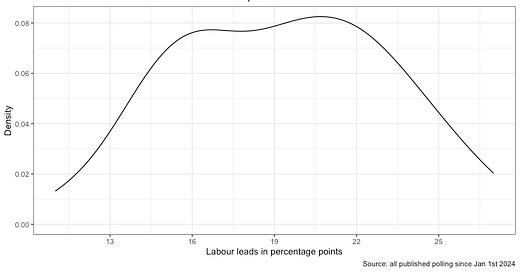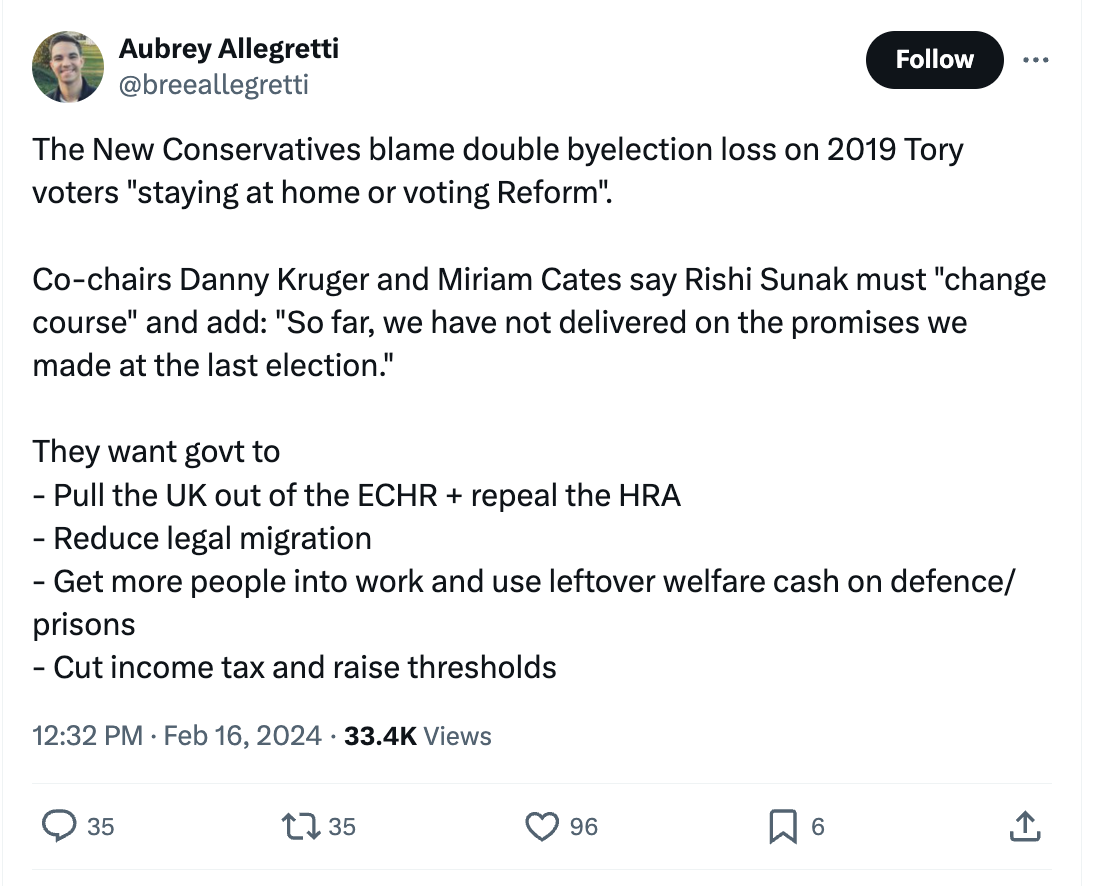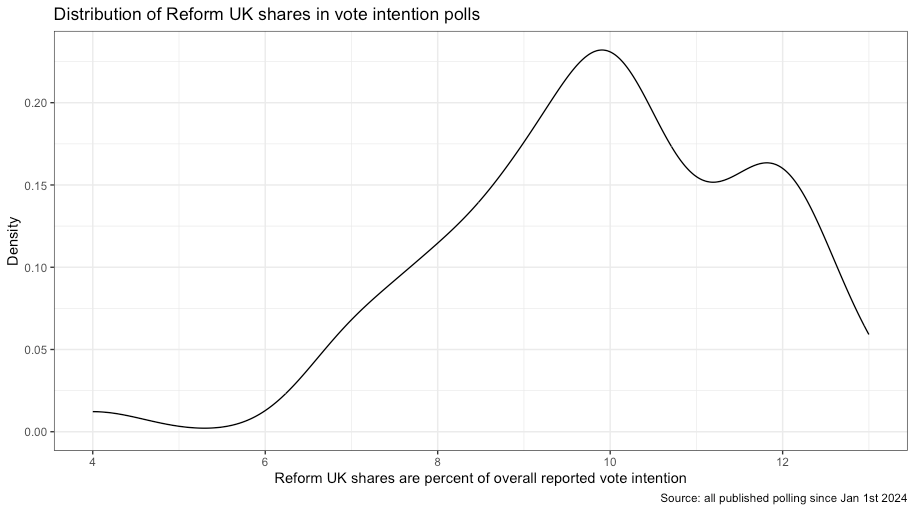Kingswood, Wellingborough, Westminster
We all know we shouldn't look to by-elections to tell us about what might happen at a general... so let's do it anyway
If a by-election take sounds implausible or silly, it’s because it most probably is. Rather, Thursday’s results were pretty well aligned with what we would expect given where the polling is right now - Con-Lab switchers, abstainers, Reform UK and all.
Hello everyone, and welcome to the latest Plain Speaking English. Just a week after the last one - as promised! A miracle!
In this issue, I’m going to look over what happened this week in Kingswood and Wellingborough but with particular reference to the current polling. Namely, do the results look in-line with what we might expect given the current opinion polling? I’ll also pass judgement a little on some of the commentary around the results, and say a quick thing or two about the Cunningham and Warren face-to-face Wellingborough poll.
First: Do the results show that there is no enthusiasm for Labour?
Aside from the obvious (and correct) takes suggesting “this is very good for Labour, and very bad for the Conservatives”, another view gained some degree of traction on social media as Friday trundled on. Here’s a variation of it from former Labour MP for Kensington, Emma Dent Coad:
The argument, as it goes, is that because Labour only put on an extra 107 votes vs its 2019 performance in Wellingborough, and “lost” 5,316 votes vs 2019 in Kingswood, that the results were actually bad for Starmer and for Labour.
Voters, as it goes, clearly were more enthusiastic for Corbyn’s Labour in 2019 than they are for that of Starmer in 2024.
But of course, by-elections don’t work like that. Raw vote numbers can’t tell us about enthusiasm levels for particular parties or leaders, or how that changes between elections, because turnout is *always* down in by-elections versus the most recent general election. Enthusiasm for by-elections themselves is lower than for general elections. There are less voters to ‘go around’ in general, in by-election contests. Comparing raw vote numbers in that context therefore simply does not work.
Why is turnout always down? Mainly because the question of “who governs” is not on the ballot paper in by-elections (unless by some wild circumstance, the result of the by-election could remove or deliver a government majority… as in 1996/7).
There are other factors, too, but the principal reasons is that by-election voters are not being asked to decide who runs the country, but rather who should be their local in MP in a parliament which has already provided the country’s government.
Second: Was it all about the Tory vote staying at home?
The suggestion that Labour’s double by-election victory was entirely down to Conservative 2019 voters staying at home, or voting Reform UK, is an equally dubious take on what happened this week.
Here’s Aubrey Allegretti from the Times reporting on this line from the ‘New Conservatives’:
In fairness, we do know from the current polling that 2019 Conservative voters are more likely to be uncertain or tell us that they simply wont vote at the next general election than voters supporting other parties. So, it is indeed likely that disproportionately more Conservative 2019 voters stayed away from the polls on Thursday than supporters of others parties.
But we also know that voters are switching between the Conservatives and Labour - 8% of them, in fact, according to the latest YouGov poll.
In fact, we can wipe away the Kruger et al. account with some quick maths, using the raw vote numbers from both contests.
In Wellingborough, around 22,000 voters stayed away from the polls who voted in 20191. The total Conservative vote dropped by almost 25,000. It is, therefore, mathematically impossible for the drop in turnout in Wellingborough to be explained by Tory 2019 voter absence.
Even adding on the Reform UK votes does not improve the plausibility much. If we assume that all Tory voters in Wellingborough did one of (a) voted Conservative again (7,408 votes), (b) voted for Reform UK (3,919 votes), or (c) stayed at home (must equal ~21,000), that suggests that over 95% of the total drop in turnout in Wellingborough was down to Tory voters staying put. Completely unrealistic.
Similarly, the total drop in turnout in Kingswood was around 24,000, and the Conservative vote total dropped by 19,000. Nearly 80% of the turnout drop coming from 2019 Tory voters is again extremely unrealistic, as it in turn implies implausibly high levels of by-election turnout from voters of all other parties.
Adding on the Reform UK numbers (2,578) to the Tory total (8,675) to make a new ‘Tory 19 stay at home’ number of about 16,500 makes the situation somewhat more believable in Kingswood, but still requires us to believe that almost 70% of the the drop in turnout from 2019 General Election to the 2024 by-election can be explained by Conservative voter absence alone. Again, not a sensible account.
Looking across the numbers, a far more realistic model would imply, exactly as the polls would suggest we should expect in a by-election”: that somewhere around 15% of Conservative 2019 voters came out and actually voted Labour between the two contests.
Third: What can the by-election results tell us about the current national polling?
Polling always gives us a much better, more consistent, reliable, regular read on public opinion and the parties than by-elections do. If we want to answer the question “What is happening in British politics right now, and who looks likely to win the next election?”, then the answer is “go and look at the opinion polls”.
That said, by-elections (as well as the annual local authority contests) can provide us with a useful check-in on how the polls are looking vis-a-vis these results of actual voting contests. In other words, we can use these elections to ‘check back’ to the polls and see if these are the kind of results we would expect if the polls were about right.
Or, alternatively, if there is a spread of leads and party shares in the polls, we can see toward which end of these spreads that the by-election results point toward.
(Edit: in a well-timed concurrent release, Dr Mark Pack reminds us that by-elections do have some fairly good predictive power in terms the general result of forthcoming general contests.)
So, are the 16pt and 29pt Con-Lab swings in Kingswood and Wellingborough broadly in line with an opposition party 10, 15, or 20 points ahead in the opinion polls?
The graph below shows the distribution of Labour leads in this year’s vote intention polling. As we can see, they range from around 25+ points (mainly from YouGov and WeThink) down toward 15 or even 10 points (mainly from More in Common, Savanta, and Opinium).
An ideal way to answer this question would be to consult with the YouGov MRP released by the Telegraph in January and compare how the seat levels results there, with a 14pt Labour national lead, compare to what we saw last night.
However, keen observers of changing British constituency boundaries will know that Kingswood is being abolished for the next general election, making it impossible to carry out such an exercise there..
Wellingborough on the other hand will be around 90% the same between now and the next general election when it becomes Wellingborough and Rushden. According to the Rallings and Thrasher notional 2019 results for new boundaries, released by the BBC this year, the changes taking place in the constituency do not alter the Con-Lab vote share baselines there all that much. Comparison between the MRP and the by-election result is therefore not completely streamline, but pretty fair.
The January YouGov MRP had Labour just winning this new seat by 37% - 34%, on a reported 14pt national Labour lead2. This week, Labour won Wellingborough by 46% - 27%.
With all pinches of salt taken, and even after adding on the anti-government by-election premium, a 19 point Labour win rather than a 3 point one suggests a current national Labour lead among those with a vote intention more toward the top end of the distribution in the graph above than the bottom.
Fourth: What about Reform UK?
Reform UK have been providing pollsters with a bit of a puzzle lately; how could they be polling nationally in double digits, but failing to register any shares or wins of significant note in by-elections or local authority contests.
In both Kingswood and Wellingborough, the Reform UK share reached north of 10 percent, perhaps seemingly solving the pollster puzzle. “The Reform surge is real”, wrote Ben Riley-Smith of the Telegraph.
But is that definitely the case? Was the Reform UK performance on Thursday around about what we would expect given their current polling?
The graph below shows that current polling in the form of another density plot. The range is pretty wide, from down to around 4-6 points (mostly from Savanta, Survation, and Deltapoll) up to 12 points and beyond (mostly from YouGov an Redfield and Wilton). The centre of the left-skewed distribution is somewhere around 10%.
Appealing again to the YouGov January MRP, we can make an educated guess at what we might expect the Reform UK share to have been in Wellingborough - a constituency with a high 2016 Leave vote.
That January model, with Reform UK on 9% nationally, had the party winning 12% of the vote in Wellingborough. On Thursday, they won 13% of that vote.
What we might suggest then (on this admittedly limited evidence) is that a reported Reform UK vote of around 10% nationally probably feels about right. Ish.
Fifth and final: A note on the Wellingborough constituency poll
In the lead up to Thursday, Kevin Cunningham and Ian Warren produced a poll of the Wellingborough by-election using the now-lesser-spotted polling methodology of face-to-face interviewing.
The poll suggested a narrow Conservative hold could be on the cards, but the intervals very much contained a Labour victory as a possibility. Essentially, the central estimate of the poll suggested the reverse of what the YouGov January MRP estimated.
As it went, the scale of Labour’s win went well beyond what was contained in the Cunningham and Warren intervals, as they stormed to a 20 point win.
But this is no ‘dunking’ post. Far from it. I’d like to say kudos to Ian and Kevin for doing it. Trying stuff is to be encouraged. Methodological diversity is great, and we should celebrate it. Even when it goes wrong.
If I were to put the miss down to one thing, I think the face-to-face poll was likely off because of false recall. YouGov powerhouse Anthony Wells wrote about false recall in reference to the 2019 general election, explaining that in the lead up to that contest, with Johnson’s Conservatives leading an increasingly unpopular Labour led by Jeremy Corbyn…
seven percentage points fewer people now recall having voted Labour at the last election, with a slight increase in the percentage of people claiming they voted for the Conservatives, Liberal Democrats, UKIP or other parties.
Fast forward to now, and the direction of travel of both (a) the general polling, and also (b) the specific contest and controversies in Wellingborough, what that means is that I would expect Conservative voters were in general harder to find than they ought to have been in Wellingborough, with many of them now falsely recalling. Further, those that were found would probably be more likely to be staying Conservative than those who are falsely recalling and saying they voted Labour in 2019.
If my assumptions are correct, that would have significantly throw off the poll as the reported figures would have had a much stickier Conservative 2019 vote than in reality. Kevin and Ian may have other (and better) explanations in the days to come, though, so watch out for them.
While I am purposefully approximating here, in reality, the figure will be a little smaller than this due to population churn.
As I noted at the time, the reason why Labour leads in the YouGov MRP are smaller than in YouGov headline vote intention polls reported weekly in Times is because the MRP model probabilistically models where the ‘unaccounted’ votes in the electorate (mainly; those telling pollster they “Don’t know” how they would vote in an election held tomorrow) will actually go if an ‘election squeeze’ were on. This approach of course ‘gives’ vote intentions to those who currently do not have one, in the same way that other reallocation approaches (such as the re-weighting model that Opinium use) will do.







